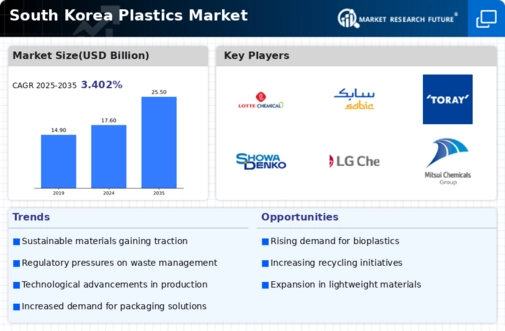The South Korea Plastics Market is an increasingly dynamic sector characterized by innovation, technological advancements, and a growing emphasis on sustainability. The market has witnessed significant growth driven by a rise in demand across various industries, including packaging, automotive, electronics, and construction. Competitive insights within the market reveal that several key players are strategically positioning themselves through mergers, acquisitions, and collaborations to enhance their market share and product portfolios. These companies are investing in research and development to create more advanced materials, focusing on eco-friendly solutions to cater to global sustainability trends.
Additionally, regulatory changes and increasing consumer awareness regarding environmental impact are shaping the competitive landscape as companies strive to adapt to new standards and meet the expectations of an evolving market.Lotte Chemical emerges as a prominent player in the South Korea Plastics Market, showcasing a strong market presence coupled with significant strengths that bolster its competitive edge. The company has established itself as a leader in the chemical industry, particularly in the production and supply of petrochemicals and advanced plastic materials.
One of the strengths of Lotte Chemical lies in its robust manufacturing facilities and efficient production processes, which ensure high-quality output. The company has also focused on expanding its offerings in specialty plastics, integrating innovative technologies to meet diverse industry requirements. With a commitment to sustainability, Lotte Chemical has initiated several green initiatives, positioning itself favorably in the face of rising environmental concerns.
This proactive approach, combined with its extensive distribution network across South Korea, enhances its ability to cater to a variety of market demands.Hyundai Chemical is another key player in the South Korea Plastics Market, leveraging its capabilities to provide a wide range of products and services to its customers. The company specializes in producing high-performance plastics, contributing significantly to sectors such as automotive, consumer goods, and industrial applications. Hyundai Chemical's strength lies in its technological advancements and commitment to innovation, which have enabled it to develop tailored solutions to meet specific customer needs.
The company has also engaged in strategic mergers and acquisitions that have expanded its operational capabilities and market reach within South Korea. Through these activities, Hyundai Chemical has strengthened its product portfolio, ensuring it remains competitive in a rapidly evolving industry. By focusing on quality and customer satisfaction, Hyundai Chemical continues to secure a solid foothold in the South Korean plastics landscape, fostering growth and sustainability in its operations.




















Leave a Comment